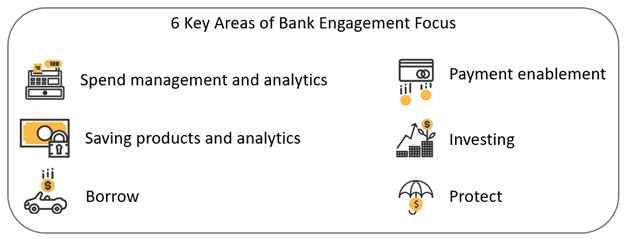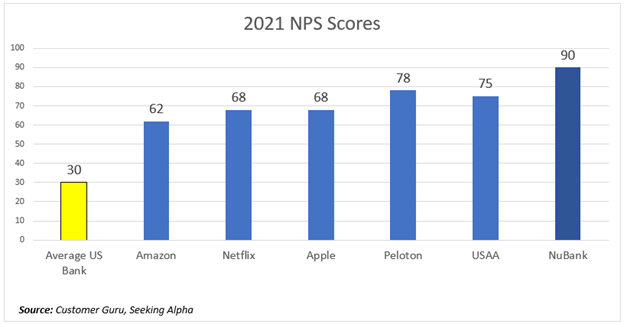Brand Differentiation – How One Bank Is Producing 132% Profit Growth
If your bank struggles to create a clear value proposition and brand differentiation, then we have a case study for you. In December 2021, a Brazilian bank, Nubank, went public in the U.S. and became the most valuable bank in Latin America. Their secret – fanatical customer service. This article looks at how this bank does it and provides a step-by-step breakdown of how you can incorporate their lessons into your bank to create outsized financial performance and differentiate franchise value.
In 2021, Nubank spent around 4% of revenue, according to their financials, in marketing which is materially below the 7% target for most banks. Instead of marketing, the Bank strategically focuses on two areas – product development and customer service.
Brand Differentiation Step 1: Build an Employee-Centric Culture
After trying to open an account at a competitor, David Velez, the Bank’s Founder and CEO, knew that banking had to be more accessible. The experience was time-consuming complicated and made David feel that he was an imposition. He vowed that he could do better.
From its start, Nubank has had the audacious goal to become the most influential financial services company in the World. It would do that by using technology, design, and data science to provide a customer experience that would generate its publicity. The founders agreed early on that the support for any decision had to first start with “This decision improves our customer’s lives by…”

Nubank does put their money where their mouth is as the culture is aligned by the award of equity incentives, a practice largely unheard of in Latin America. For the Bank, as of the end of 2021, approximately 76% of employees had either Nubank shares or share-based incentives as part of their compensation.
Step 2: Invest in Products That Engage The Customer
As we broke down HERE, banks consistently underinvest in product development. Nubank is an example of what happens when you invest in your products in order to differentiate your brand.
Closely aligned with customers service, bank management recognized early on during its maturity that it needed a platform ecosystem to drive engagement. Since Nubank has no branches, it needed to provide easy-to-use mobile-first products and products that their target consumer and commercial customers need and products that drive engagement. Where most banks choose to focus just on two or three of the traditional areas of investment, Nubank decided to invest in at least one product in each of the six traditional areas (below).

Nubank started with a credit card offering, followed by deposit accounts, then lending, and then payments, investing, and insurance. The multiple products created a marketing path so it could hook a customer on one product and then try to transition them to other products. With each new product, the Bank introduced increased profitability and increased its engagement rate and retention, thereby boosting customer lifetime value.
The latest example of that was real-time payments (RTP). While most competitor banks lagged the rollout of RTP, Nubank embraced it, and now 20% of all customers use the payment platform in less than a year. More importantly, RTP has been a material source for customer acquisition.
The product lineup was responsible for brand differentiation as well as moving key performance metrics. Average Revenue Per Active Customer (ARPAC), one of our favorite metrics, increased by 70%. Having more products on their platform also helped defray the cost and scale. As a result, the Average Cost to Serve Per Active Customer dropped 20.4% for 2021. In general, because each product is built on the same technology platform and there are no branches, general and administrative expenses are approximately 85% lower than incumbent banks. The Bank also tracks those customers that have their primary transaction account with the Bank, and that number hit a record 55%.
Step 3: Invest in Credit Underwriting
A bank can be considered a manufacturing plant of credit. If true, it makes sense to produce the highest quality credit product in the most efficient way possible and make it central to your strategy.
Early in its development, most off-the-shelf credit models failed to give the Bank the granularity that it needed. Further, the data required for most data models, such as credit score, lagged by days or months and couldn’t give Nubank an accurate enough picture. While Buy Now Pay Later (BNPL) instant credit models are now commonplace, back in 2018, Nubank had to develop its own. Using data and testing various hypotheses, Nubank found several insights that helped propel its growth.
It found that a quality customer providing a referral was worth multiple times a normal referral. Not only was credit better, but customer lifetime value was a multiple of the average. Thus, where most banks would focus on a referral program, Nubank ranked the quality of the referee and allocated more capital into acquiring the customer they referred.
The second significant insight that propelled Nubank was the notion that you could be a poor credit risk now, but if you fit a particular profile, you still deserve credit as you have the markers to be a better credit risk soon. Here, young customers with no credit, households that just hit a rough patch such as a job loss, or customers who had to acquire more debt than healthy and have now started to pay it down would traditionally be turned down by some banks. Using its data, Nubank would grant some credit, even if it was $15, and then help the customer manage payments. Using alerts, credit score management advice, and transaction data, it would then quickly expand (or contract in some cases) the credit limit to help the customer.
The targeted extension of credit helped reduce customer acquisition costs, increase profitability, boost loyalty and promote brand differentiation.
Step 4: Reallocate Advertising Dollars into Customer Service
At the heart of the Bank’s brand differentiation strategy is superior customer service driven by “XPeers.” Xpeers are customer support help reachable by phone, chat, social media, or email. Xpeers are hired explicitly for their customer service orientation and then trained in the Nubank culture. Xpeers then train in specialties and are matched with the problem.
Using data from past problems and then looking at the customer’s products, the contact is served solutions to highly probable problems through the communication channel of choice. The result is an efficient, superior level of customer service.
For starters, 90% of support contacts are answered in less than 45 seconds – a response time unheard of at most every bank. 92% of the contacts rank Nubanks customers service as either a “four” or “five” rating out of five. Nubank’s other metric is complaints. The Bank receives 269 complaints per million customers, a small fraction of the 1,420 complaints per million of the average financial institution.
On top of that, every Xpeer has a discretionary budget to handle the “WoWing” of customers. Should the Xpeer encounter a customer problem or area where they could delight the customer, the Xpeer sent a small gift and a handwritten note. It was not uncommon for a customer to receive a baby, wedding, or a gift that said, “I am sorry.” Last summer, the Xpeers took this sentiment to the next level with their “#NuArmor” social media campaign. They searched social media for customers who had significant events such as an engagement and then sent them a gift.
This customer service strategy has resulted in customer growth of 3.7mm users in 2018 to 48.1mm users in 2021, and the Bank is currently on track to achieve its 108mm customer target by 2025. It has a Net Promoter Score (NPS) of 90, which is 3x above the average bank in the U.S. and above USAA, the bank with the highest NPS in the U.S. but also higher than NPS notables Peloton, Apple, and others (below).

At this level of performance, almost 90% of their new customers come from word-of-mouth or unpaid referrals.
Putting This Brand Differentiation Into Practice
Nubank takes a foundation of employee and customer-centric culture, focuses on platform product development, and compliments data analytics with organic intelligence to form a differentiated brand offering to become one of the highest-rated and fastest-growing banks in the World.
Nubank follows the formula of some of the best companies on earth. They underinvest in pre-purchase advertising and overinvest in the customer experience. They take the bank and focus on underserved communities by overserving them. They use that loyalty and profit to expand into other services to build out the platform further while making sure they have operating leverage.
It is easy to dismiss Nubank’s strategy as a strategy of a $20B bank. However, the above is the same strategy they have had since their founding in 2013. It worked when they were a $500 million bank, it worked as a $2B bank, and it is working as a $20B bank. Nubank doesn’t have this strategy because of its size.
They have the size because of their strategy.

